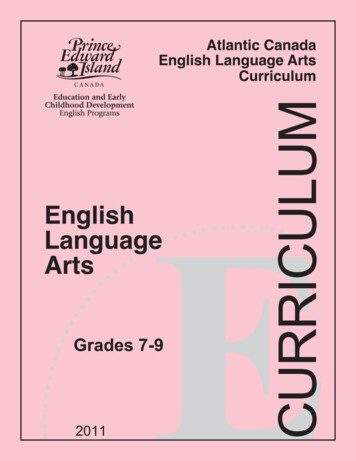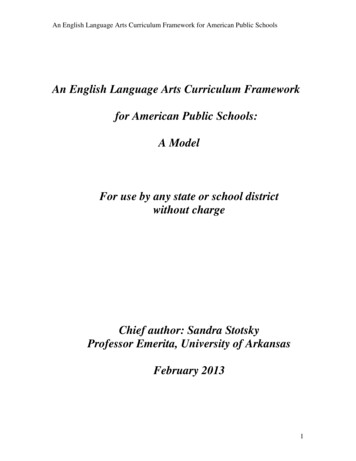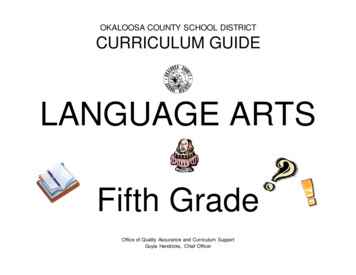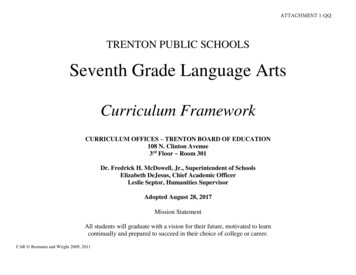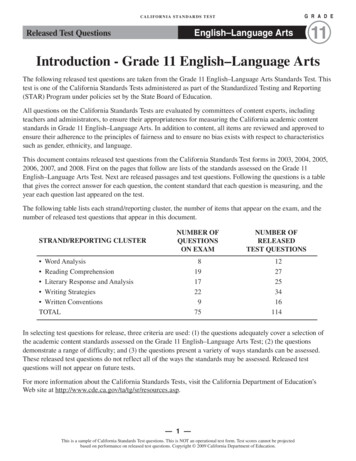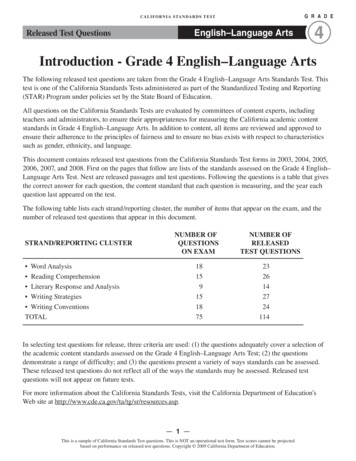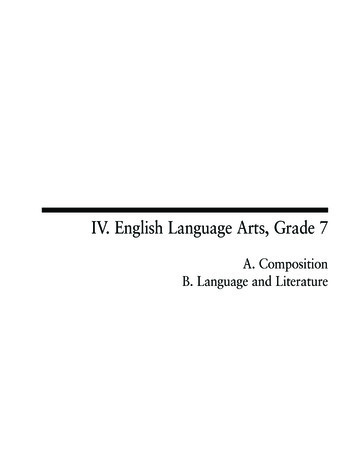
Transcription
IV. English Language Arts, Grade 7 A. CompositionB. Language and Literature
Grade 7 English Language Arts Test Test StructureThe Grade 7 MCAS English Language Arts Test was presented in the following two parts: the ELA Composition Test, which used a writing prompt to assess learningstandards from the Massachusetts English Language Arts Curriculum Framework’sComposition strand the ELA Language and Literature Test, which used multiple-choice and openresponse questions (items) to assess learning standards from the CurriculumFramework’s Language and Reading and Literature strandsA. Composition The spring 2005 Grade 7 MCAS English Language Arts Composition Test and Make-UpTest were based on learning standards in the Composition strand of the MassachusettsEnglish Language Arts Curriculum Framework (2001). The learning standards for theComposition strand appear on pages 72–83 of the Framework, which is available on theDepartment Web site at www.doe.mass.edu/frameworks/ela/0601.pdf.In Test Item Analysis Reports and on the Subject Area Subscore pages of the MCASSchool Reports and District Reports, ELA Composition test results are reported under theComposition reporting category.Test Sessions and Content OverviewThe MCAS ELA Composition Test included two separate test sessions, administered onthe same day with a short break between sessions. During the first session, each studentwrote an initial draft of a composition in response to the appropriate writing prompt onthe next page. During the second session, each student revised his/her draft and submitteda final composition, which was scored in the areas of Topic Development and StandardEnglish Conventions. The MCAS Writing Score Guide (Composition Grade 7) is availableat ference Materials and ToolsAt least one English-language dictionary per classroom was provided for student useduring ELA Composition test sessions. The use of bilingual word-to-word dictionarieswas allowed for limited English proficient students only. No other reference materials ortools were allowed during either ELA Composition test session.Cross-Reference InformationFramework general standards 19–22 are assessed by the ELA Composition.70
English Language Arts Composition, Grade 7Grade 7 Writing PromptWRITING PROMPTSeventh grade is an important year. Learning new things and having newexperiences may have changed you.Your English teacher would like you to write about how you have changed sincethe beginning of the year. In a well-developed composition, describe two ways inwhich you have changed and explain what effect they have had on your life.Grade 7 Make-Up Writing PromptWRITING PROMPTMany people like to have a place where they can go to relax or unwind. It could beindoors or outdoors. Some people prefer quiet surroundings, while others like a busieratmosphere.Think about a place you like to go to relax or unwind. In a well-developedcomposition, describe the place and explain why it is relaxing.71
B. Language and Literature The spring 2005 Grade 7 MCAS English Language Arts Language and Literature Testwas based on learning standards in the two content strands of the Massachusetts EnglishLanguage Arts Curriculum Framework (2001) listed below. Page numbers for thelearning standards appear in parentheses. Language (Framework, pages 19–26) Reading and Literature (Framework, pages 35–64)The English Language Arts Curriculum Framework is available on the DepartmentWeb site at www.doe.mass.edu/frameworks/ela/0601.pdf.In Test Item Analysis Reports and on the Subject Area Subscore pages of the MCASSchool Reports and District Reports, ELA Language and Literature test results arereported under two MCAS reporting categories: Language and Reading and Literature,which are identical to the two Framework content strands listed above.Test Sessions and Content OverviewThe MCAS Grade 7 ELA Language and Literature Test included three separate testsessions. Each session included selected readings, followed by multiple-choice and openresponse questions. Common reading passages and test items are shown on the followingpages as they appeared in test booklets. Due to copyright restrictions, certain readingpassages cannot be released to the public on the Web site. All of these passages appear inthe printed version of this document.Reference Materials and ToolsThe use of bilingual word-to-word dictionaries was allowed for limited English proficientstudents only, during all three ELA Language and Literature test sessions. No otherreference materials were allowed during any ELA Language and Literature test session.Cross-Reference InformationThe table at the conclusion of this chapter indicates each item’s reporting category and theFramework general standard it assesses. The correct answers for multiple-choice questionsare also displayed in the table.72
English Language Arts LANGUAGE AND LITERATURE: SESSION 1DIRECTIONSThis session contains three reading selections with sixteen multiple-choice questions andtwo open-response questions. Mark your answers to these questions in the spaces provided inyour Student Answer Booklet.Dogs0704I CWhich animals are the smartest? Are horses smarter than dogs, and are dogs smarter than cats? Aremonkeys smarter than all three? Scientists have long wondered how to measure an animal’s intelligence.Read the article to see why determining animal intelligence is so difficult. Use information from the articleto answer the questions that follow.Are Dogs Dumb? by Karen Hopkin12345Chimps can use sign language to talk to their trainers. Monkeys can learnto count. A crow can figure out how to use a stick to get at that hard-to-reachgrub. Chickens can learn to play checkers. Even worms can be taught to runmazes. So which animal is the smartest? You’re probably thinking that chimpsare smarter than chickens. And that crows are smarter than worms. And thatyou’re smarter than all of them.But where do those rankings come from? Okay, you probably are smarterthan the average worm. But why do we assume that bigger beasts are smarterthan smaller ones? Or that furry critters are brainier than slithering wrigglersthat are coated in slime?And how come we think dogs are so smart? Sure, a dog might be cleverenough to fetch his leash when he wants to go out. But the same mutt mightalso bark at the vacuum cleaner and spend a whole hour chasing his own tail.Is Rover really any brighter than a hamster, a chicken, or that kid who’salways eating Play-Doh? How can you measure an animal’s brain power?The hardest part is coming up with the right test. A dog can’t sit downwith a No. 2 pencil and take a multiple choice exam. So the test has to besomething the dog can learn to do: select a block by nudging it with a nose ora paw, for example. The test also has to be something the dog wants to do: adog might stare at that block all day without budging—until she figures outthat there’s a treat hidden underneath.Norton Milgram and his co-workers at the University of Toronto atScarborough use treats to give dogs a Canine IQ test. The dog is presentedwith a tray with a blue block on it; underneath the block is a treat. The animalmoves the block and gets the treat. So far, so good. Now the test gets tricky.The dog is presented with the same tray, but this time it has both a blue blockand a yellow coffee can lid (or white bowl or black square of cloth) on it; the73
English Language Arts67891011Session 1 treat is now under the yellow lid (or white bowl, etc.). The test: how long doesit take for the dog to learn that the treat is always under the new item on thetray? The smarter the dog, the quicker she’ll find the treat.That seems simple enough, but things become more complicated whenyou try to compare different kinds of animals. Monkeys wipe the floor withdogs on this test. Dogs may have to try hundreds of times before they selectthe yellow lid nine out of ten times. Monkeys learn much more quickly tofind the hidden treat. Does that mean monkeys are smarter than dogs?Not necessarily. The test was originally designed for monkeys, and it gives them an unfair advantage: by nature monkeys are curious and like to check out new things. Dogs, on the other hand, tend to be wary about approaching new things. As Stephen Budiansky reports in his book The Truth about Dogs, one pooch was so scared of the yellow lid that he had to be excused from the study. If the test is made more dog-friendly, on the other hand, canines do just fine. Instead of introducing a yellow lid, the treat is put under another blue block on the opposite side of the tray. Dogs learn as quickly as any monkey that the treat is always on the side opposite the first block they saw. Even if you could find a test that was perfectly fair to all animals, in away it’s silly to ask whether one kind of animal is smarter than another. Allanimals have the ability to learn things that are important to them. Otherwisethey wouldn’t survive. A chicken doesn’t need to be a chess champion tofigure out where to get food or how to run from a predator. So a chicken isas smart as it needs to be to earn a living as a chicken.If you still believe that dogs are much smarter than chickens, it’s probablybecause dogs are good at learning the things we want them to learn: fetchingthe newspaper, for example. Try to convince a chicken to do that! The truth is,most dog tricks take advantage of dogs’ built-in behavior patterns—things thatdogs are born knowing how to do or learn easily. Chasing and retrieving areleftover hunting behaviors. For a dog, fetching the paper or a tennis ball is not areflection of intelligence. It’s basically a demonstration that dogs will be dogs.Canines may not be the deepest thinkers in the world. But perhaps that’sfor the best. The life of a dog—sitting alone all day, waiting for everyoneto come home—can be pretty boring. Super-smart animals would probablyget totally stressed out, says Serpell. Look at it this way: if dogs were anysmarter, they probably wouldn’t choose to hang around with us.Reprinted by permission of MUSE magazine, November/December 2002, Vol. 6, No. 9, 2002 by Karen Hopkin.74
English Language ArtsSession 11 3068883–Dogs0704I C1 3068880–Dogs0704I C3 What is the main idea of this article?A. Scientists have proven that monkeysare smarter than dogs becausemonkeys can count.A. Monkeys learn quickly, but dogslearn slowly.B. A University of Toronto researchgroup discovered how to accuratelymeasure animal intelligence.B. Monkeys are willing to take tests, butdogs dislike taking them.C. Monkeys investigate new things, butdogs shy away from them. *C. Dogs are smarter than otheranimals because dogs think morelike humans.D. Monkeys do not like working withhumans, but dogs do.D. Animals have different levels ofintelligence that can be measuredonly with the right tests. *3068895–Dogs0704I C4 3068874–Dogs0704I C2 According to paragraph 7, how aremonkeys and dogs different?According to paragraph 4, what isa requirement for a test of animalintelligence?Which of the following most nearly meansthe same as the phrase “to earn a living asa chicken” in paragraph 9?A. to purchaseB. to survive *A. The test must be given while theanimal is in obedience training.C. to performD. to learnB. The test must include ablock-like object.C. The test must compare twodifferent animals.D. The test must be something thatcan be taught to an animal. *75
English Language ArtsSession 1 3068885–Dogs0704I C 53068877–Dogs0704I C7 According to the article, what makeshumans think that dogs are smart?A. Dogs do things that humans wantthem to do. *A. Monkeys have learned to clean floors.B. Monkeys are neater than dogs.B. Dogs perform well on tests designedfor humans.C. Monkeys perform better than dogs. *D. Monkeys like to compete with dogs.C. Dogs are able to communicatewith humans.D. Dogs wait patiently for humans tocome home.3068882–Dogs0704I C6 What does the phrase “Monkeys wipe thefloor with dogs . . .” in paragraph 6 mean?According to the article, which of thefollowing statements is true?A. Bigger animals are smarter thansmaller animals.B. Animals cannot learn to do anythingthey are not born knowing how to do.C. The smartest animals make thebest pets.D. Most animals are as smart as theyneed to be. *76
English Language ArtsSession 1 Write your answer to open-response question 8 in the space provided in your Student AnswerBooklet.3068787–Dogs0704I C8 Describe some problems that scientists face when designing intelligence tests for animals.Use relevant and specific information from the article to support your answer.77
English Language ArtsSession 1 Baiame0704L CFor centuries, different civilizations have created stories about the origin of the Earth. Read the followingmyth from the tradition of Australian Aborigines to find out how they believe the Earth was created. Useinformation from the myth to answer the questions that follow.Baiame,the Great SpiritStudents read a selection titled “Baiame, the Great Spirit” and then answered questions 9 through 13 that follow on the nextpage of this document.Due to copyright restrictions, the selection cannot be releasedto the public over the Internet. However, the selection is printedin the publication Release of Spring 2005 Test Items, which hasbeen sent to schools and libraries across the state. For moreinformation, see the copyright citation below.“Baiame, the Great Spirit” from OUT OF THE ARK: STORIES’ RELIGIONS, copyright 1996 byFROM THE WORLD'SAnita Ganeri, reprinted by permission of Harcourt, Inc.78
English Language ArtsSession 1 3068900–Baiame0704L C 93068916–Baiame0704L C12 Which of these quotes from the myth helpsthe reader identify the story as a myth?A. “This was when the spirits lived onEarth with the people and animals,and the landscape took its shape.” *A. The village is deserted by the people.B. The people have changed theirminds about the flowers.B. “The dry, brown earth bloomedwith grass, flowers, and trees.”C. The flowers they picked havenot wilted. *C. “The bees couldn’t find anyflower pollen, so they couldn’tmake any honey.”D. The journey takes longer thanthey expected.D. “It was steep and jagged, and manya time they nearly gave up.”3189854–Baiame0704L C13 3068899–Baiame0704L C10 According to the myth, why were animalsand humans very small long ago?What is the meaning of the wordconsternation as it is used inparagraph 5?A. confusion *A. They were frequently sick.B. happinessB. They had no room to grow. *C. boredomC. They had to be smaller than Baiame.D. peacefulnessD. They were cursed by a magic spell.3068901–Baiame0704L C11 In the myth, what surprises the menon their return from seeing Baiame?According to the myth, the people seeBaiame asA. a conquering hero.B. a fellow human.C. a powerful being. *D. a selfish ruler.79
English Language Arts Session 1 Snow0704P CSometimes pets and their owners have different views about the same things. Read the exchange betweenan owner and her cat in the poem “On A Night of Snow.” Answer the questions that follow.On a Night of Snow5 1015Cat, if you go outdoors you must walk in the snow.You will come back with little white shoes on your feet,little white slippers of snow that have heels of sleet.Stay by the fire, my cat. Lie still, do not go.See how the flames are leaping and hissing low;I will bring you a saucer of milk like a marguerite,1so white and so smooth, so spherical and so sweet—stay with me, Cat. Outdoors the wild winds blow.Outdoors the wild winds blow, Mistress, and dark is thenight,strange voices cry in the trees, intoning2 strange lore;and more than cats move, lit by our eyes’ green light,on silent feet where the meadow grasses hang hoar3—Mistress, there are portents4 abroad of magic and mightand things that are yet to be done. Open the door!ELIZABETH COATSWORTH1marguerite — daisy intoning — singing 3hoar — covered with frost 4portents — signs of things to come 2Paterson Marsh Ltd on behalf of the Estate of Elizabeth Coatsworth.80
English Language ArtsSession 1 3126535–Snow0704P C 143126537–Snow0704P C16 What mood is conveyed by the phrase,“wild winds blow” in stanza 1?What is the effect of line 5 in the poem?A. The fire seems to be alive. *A. hopeB. The fire has gone out.B. danger *C. The fire looks out of control.C. comfortD. The fire is unimportant.D. adventure3126543–Snow0704P C17 3126544–Snow0704P C 15Which of the following best describes thecharacter of Mistress in the poem?Which of the following best explains whyan exclamation mark is used at the end ofthe last sentence of the poem?A. to emphasize that Mistress insists thatCat stay insideA. protective *B. carefreeB. to emphasize that Mistress does notcare about Cat’s needsC. forcefulD. understandingC. to emphasize that Cat does not want tobe around MistressD. to emphasize that Cat really wantsMistress to let him outside *81
English Language ArtsSession 1 Write your answer to open-response question 18 in the space provided in your Student AnswerBooklet.3126488–Snow0704P C18 Explain the two contrasting points of view presented by Mistress and Cat in the poem. Use relevantand specific information from the poem to support your answer.82
English Language Arts LANGUAGE AND LITERATURE: SESSION 2DIRECTIONSThis session contains one reading selection with seven multiple-choice questions and oneopen-response question. Mark your answers to these questions in the spaces provided inyour Student Answer Booklet.Jetty0703L CA1 2TO TH E JKE TALby Jamaica Kincaid TYWA teenage girl from the island of Antigua is being sent to live with relatives in England where she willattend nursing school. As she walks with her parents along the jetty where a boat awaits her, sheremembers the walks to the jetty she used to take with her father in years past. This young girl has mixedfeelings about leaving. Read this excerpt from the novel Annie John to see what happens. Answer thequestions that follow.My heart now beat fast, and no matter how hard I tried, Icouldn’t keep my mouth from falling open and my nostrilsfrom spreading to the ends of my face. My old fear of slippingbetween the boards of the jetty and falling into the dark-greenwater where the dark-green eels lived came over me. When myfather’s stomach started to go bad, the doctor had recommended a walk every evening right after he ate his dinner.Sometimes he would take me with him. When he took me withhim, we usually went to the jetty, and there he would sit andtalk to the night watchman about cricket1 or some other thingthat didn’t interest me, because it was not personal; they didn’ttalk about their wives, or their children, or their parents, orabout any of their likes and dislikes. They talked about thingsin such a strange way, and I didn’t see what they found funny,but sometimes they made each other laugh so much that theirguffaws2 would bound out to sea and send back an echo. I wasalways sorry when we got to the jetty and saw that the nightwatchman on duty was the one he enjoyed speaking to; it waslike being locked up in a book filled with numbers and diagrams and what-ifs. For the thing about not being able tounderstand and enjoy what they were saying was I had nothing to take my mind off my fear of slipping in between theboards of the jetty.Now, too, I had nothing to take my mind off what washappening to me. My mother and my father—I was leavingthem forever. My home on an island—I was leaving it forever.1cricket — an outdoor game played with bats, a ball, and wickets by two teams of eleven eachguffaw — a hearty burst of laughter283
English Language Arts33Session 2 What to make of everything? I felt a familiar hollow spaceinside. I felt I was being held down against my will. I felt I wasburning up from head to toe. I felt that someone was tearingme up into little pieces and soon I would be able to see all thelittle pieces as they floated out into nothing in the deep bluesea. I didn’t know whether to laugh or cry. I could see that itwould be better not to think too clearly about any one thing.The launch was being made ready to take me, along with someother passengers, out to the ship that was anchored in the sea.My father paid our fares, and we joined a line of people waitingto board. My mother checked my bag to make sure that I hadmy passport, the money she had given me, and a sheet of paperplaced between some pages in my Bible on which were writtenthe names of the relatives—people I had not known existed—with whom I would live in England. Across from the jetty was awharf, and some stevedores3 were loading and unloadingbarges. I don’t know why seeing that struck me so, but suddenly a wave of strong feeling came over me, and my heart swelledwith a great gladness as the words “I shall never see this again”spilled out inside me. But then, just as quickly, my heart shriveled up and the words “I shall never see this again” stabbed atme. I don’t know what stopped me from falling in a heap at myparents’ feet.When we were all on board, the launch headed out to sea.Away from the jetty, the water became the customary blue, andthe launch left a wide path in it that looked like a road. I passedby sounds and smells that were so familiar that I had long agostopped paying any attention to them. But now here they were,and the ever-present “I shall never see this again” bobbed upand down inside me. There was the sound of the seagull divingdown into the water and coming up with something silverish inits mouth. There was the smell of the sea and the sight of smallpieces of rubbish floating around in it. There were boats filledwith fishermen coming in early. There was the sound of theirvoices as they shouted greetings to each other. There was thehot sun, there was the blue sea, there was the blue sky. Notvery far away, there was the white sand of the shore, with therun-down houses all crowded in next to each other, for in someplaces only poor people lived near the shore. I was seated inthe launch between my parents, and when I realized that I wasgripping their hands tightly I glanced quickly to see if they werelooking at me with scorn, for I felt sure that they must havestevedore — one who loads or unloads ships or barges84
English Language ArtsSession 2 known of my never-see-this-again feelings. But instead myfather kissed me on the forehead and my mother kissed me onthe mouth, and they both gave over their hands to me, so that Icould grip them as much as I wanted. I was on the verge offeeling that it had all been a mistake, but I remembered that Iwasn’t a child anymore, and that now when I made up my mindabout something I had to see it through. At that moment, wecame to the ship, and that was that.Excerpt from “A Walk to the Jetty” from ANNIE JOHN by Jamaica Kincaid. Copyright 1985 by Jamaica Kincaid. Reprinted bypermission of Farrar, Straus and Giroux, LLC.3016248-Jetty0703L C 19193016256-Jetty0703L CWhich sentence best expresses the mainidea of this excerpt?Read the sentence from paragraph 2 in thebox below.A. Long journeys require advancedplanning.I felt a familiar hollow space inside.B. Success is the result of hard work.2121 C. Growing up involves overcomingone’s fears. *Which word best describes thespeaker’s emotion?A. joyD. One person’s loss is another’s gain.B. guilt3016255-Jetty0703L C2020 C. appreciationIn paragraph 1, what had originallybrought the speaker to the jetty?D. fear *A. The speaker was a young girl wholiked cricket.B. The speaker’s family was goingon a voyage.C. The speaker’s father had an illness. *D. The speaker was a fisherman’s daughter.85
English Language ArtsSession 2 3044692–Jetty0703L C3016247-Jetty0703L CRead the sentence from paragraph 3 in thebox below.Read the phrase from the beginning of paragraph 3in the box below.There was the hot sun, there wasthe blue sea, there was the blue sky.22 Away from the jetty, the water became the customary blue . . . What is the effect of the repetition of thephrase “There was”?24 A. It conveys the speaker’s eagerness togo to England.A. The water looks as it does beforea storm.B. It captures how boring the speaker’slife has become.B. The water looks as it usually doesaway from the shoreline. *C. It shows that these things are unusualto the speaker.C. The water looks as it does duringhigh tide.D. It emphasizes the power of thespeaker’s connection to her home. *D. The water looks as it doesduring sunset.3016844-Jetty0703L C 23What does the word customary tell thereader about the water?3044696–Jetty0703L CWhy does the speaker finally decidethat leaving Antigua to live inEngland is not a mistake?Read the excerpt from paragraph 3 in thebox below.A. She dislikes living near the jettyand the overcrowded housing. . . I felt sure that theymust have known of mynever-see-this-again feelings.B. She feels she has to grow up andmust stick to her decisions. *2525 C. She dislikes the smell of the seaand the sight of floating rubbish.The phrase “never-see-this-again” is usedas which part of speech in this excerpt?A. a nounD. She is angry with her parentsfor making her leave home.B. a verbC. an adjective *D. an adverb86
English Language ArtsSession 2 Write your answer to open-response question 26 in the space provided in your Student AnswerBooklet.3016251-Jetty0703L C2626 Identify and explain the mixed feelings the speaker has about leaving her home.Use relevant and specific information from the excerpt to support your answer.87
English Language Arts LANGUAGE AND LITERATURE: SESSION 3DIRECTIONSThis session contains two reading selections with thirteen multiple-choice questions and oneopen-response question. Mark your answers to these questions in the spaces provided in yourStudent Answer Booklet.Alien0704I CWhat happens when exotic species of life are transported to a place where they have no natural predators?These biological invaders can cause problems around the world. Read the excerpt from the article,“Stopping the Alien Invaders,” to find out how the government in Hawaii takes steps to prevent alieninvaders from destroying native plants and animals. Use information from the excerpt to answer thequestions that follow.Stopping thethe Alien Invadersaders by Sneed B. Collard III12What are these organisms? They can be plants, animals, fungi, viruses, bacteria, or any other life form you can think of. The one thing they all have in common is that they are living in places where they don’t belong. A 1993 study by the U.S. Congress Office of Technology Assessment reported that at least 4,500 exotic species have established themselves in the United States. Over 600 of these cause serious problems. Exotic diseases such as AIDS and Lyme disease endanger human health. Exotic insects such as fire ants damage farm equipment, sting people, and kill native animals. Exotic weeds of many kinds take over farmland. Some, such as the paperbark tree from Australia, threaten to take over Everglades National Park and other natural areas. 883 4 Since the turn of the century, 79biological invaders alone have cost theU.S. economy 97 billion dollars. Everystate has been affected, but some havebeen hit especially hard. These includeCalifornia, Florida, and—more thananywhere else—Hawaii.Hawaii is an important tradingcenter and home to over a dozenmilitary bases. About six million touristsvisit the Hawaiian islands every year.With all that traffic in and out, exoticspecies have plenty of opportunities toreach the islands. Some invaders, suchas pets and garden plants, are brought inon purpose. Others, like the brown treesnake, sneak in with food, militaryequipment, furniture, and even theU.S. mail.
English Language Arts56789Session 3 According to biologists who work inHawaii, exotic species are the numberone threat to the state’s economy,environment, and way of life. Exoticagricultural pests damage crops andprevent farmers from selling millions ofdollars’ worth of fruits and vegetables tothe mainland. Exotic goats, pigs, andother mammals rip up Hawaii’s rainforests. Exotic parasites* such asmosquitoes spread deadly diseases tonative birds.The question in Hawaii and otherplaces is, can the invaders be stopped?Despite our best efforts, many exoticspecies will continue to reach newplaces around the world. Some will beimported intentionally. Others will bebrought in by accident. However, thereis a lot we can do to slow the rate ofbiological invasions.Quarantines are one way to do this.Quarantine is the process of isolatinganimals or products. In Hawaii, pet dogsand cats coming into the state remain ina special holding facility for fourmonths to make sure they don’t haverabies. Many agricultural products arealso quarantined to see if they arecarrying insect pests or plant diseases.Inspection is a second way to stopbiological invaders. At airports, borders,and shipping ports, inspectors examinepassengers and their baggage to see ifthey are carrying exotic species. Theinspectors confiscate and destroy fruits,1011*vegetables, or other goods that might becarrying harmful pests or diseases.Specially trained dogs also sniff cargofor exotic species, such as the browntree snake.What if an exotic species slips byinspectors? Then efforts are made tocontrol the invader. In Hawaii,government agencies control invadersby setting livetraps around wildliferefuges and other places. The traps catchexotic cats, rats, and mongooses that eatnative birds and their eggs. At HaleakalaNational Park employees have builtmiles of fences to keep out exotic pigsand goats. For years these animals ateand trampled native rain forest plants,but the fences have helped reverse thisdamage. Now native plants grow inplaces that were bare rock only a shorttime ago.In some cases biological controlhelps to solve the exotic speciesproblem. Biological control or“biocontrol” is the science of controllingone invader with another. In the early1900s, several exotic predators wereimported to Hawaii to eat a harmfulexotic pest called the sugarcanel
B. Language and Literature The spring 2005 Grade 7 MCAS English Language Arts Language and Literature Test was based on learning standards in the two content strands of the Massachusetts English Language Arts Curriculum Framework (2001) listed below. Page
